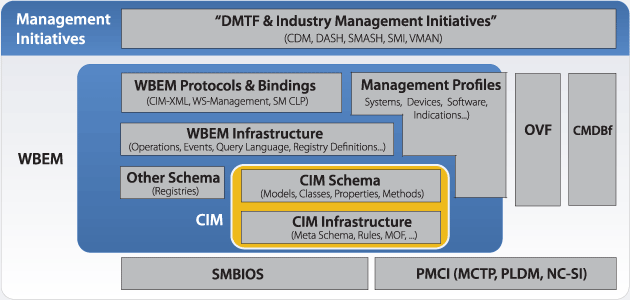- DMTF 日本
- Home
- About DMTF
- Standards & Technology
- All DMTF Standard Publications
- Common Diagnostic Model (CDM)
- Desktop and mobile Architecture for System Hardware (DASH)
- Systems Management Architecture for Server Hardware (SMASH)
- Virtualization Management (VMAN)
- Common Information Model (CIM) Standards
- Configuration Management Database Federation (CMDBf)
- Platform Management Components Intercommunication (PMCI) Standards
- System Management BIOS (SMBIOS) Specification
- Storage Management Initiative (SMI)
- Web-Based Enterprise Management (WBEM)
- Web Services Management
- Management Profiles
- Technologies Diagram
- Works in Progress
- Technology Submission and Feedback Portal
- Historical Documents
- Cloud
- DMI Self-Certification
- News & Events
- Learning Center
- Conformance
- Join Us
DMTF Technologies Diagram

The DMTF’s technologies are designed to work together to address the industry’s needs and requirements for interoperable distributed management. These standards provide well-defined interfaces that build upon each other, delivering end-to-end management capabilities and interoperability. The interrelationships between the DMTF technologies in this diagram deliver incremental value throughout the stack, building added value with each additional layer that is implemented.
As the diagram shows, the foundation of the DMTF’s technologies is the Common Information Model (CIM). The CIM Infrastructure specification defines CIM’s “rules" and provides the details for integration with other management models. The next layer is the CIM Schema, which delivers semantically rich, object-oriented model descriptions for all managed elements. The CIM Schema facilitates streamlined integration and reduced costs by enabling the exchange of management information in a platform-independent and technology-neutral way.
Building upon CIM is the DMTF’s Web-Based Enterprise Management (WBEM), a set of management and Internet standard technologies developed to unify the management of distributed computing environments. WBEM provides the ability for the industry to deliver a well-integrated set of standard-based management tools, facilitating the exchange of data across otherwise disparate technologies and platforms.
Also included in this diagram are Profiles, which provide a template to address specific management domains. By delivering a unified way to describe a given management domain in CIM, Profiles help with ease of use and offer a simplified means to achieve interoperable distributed management.
On top are the Management Initiatives – major focus areas within the DMTF, as well as other industry organizations – that are built upon DMTF technologies. These initiatives, which deliver functionality to specific vertical applications and industries, include important implementations such as the DMTF's Virtualization Management Initiative (VMAN), Systems Management Architecture for Server Hardware (SMASH), and Common Diagnostic Model (CDM), as well as the Storage Networking Industry Association’s (SNIA’s) Storage Management Initiative Specification (SMI-S).
These technologies from the DMTF deliver potent solutions, helping alleviate the challenges associated with managing today’s complex, heterogeneous technology environments.
DMTF Feedback Policy
The DMTF welcomes feedback on our standards, but requires that individuals submitting comments first agree to our DMTF Feedback Policy.
